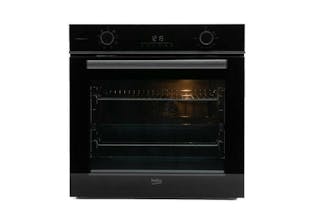How we test wall ovens
Find out how we test wall ovens to see how they perform for a range of cooking tests and how easy they are to use. We’ve tested 30 new and 18 discontinued models.
We’ve put 600mm and 900mm wall ovens through a range of everyday cooking tests and found out how easy they are to use and clean.
Lifetime score
Our overall score combines test performance (how well the appliance works and how easy it is to use) with predicted reliability (how likely models from the brand are to remain free of faults) and brand satisfaction (how satisfied owners of the brand’s appliances are likely to be).
Test performance
It’s no good if a product lasts for several decades if it doesn’t work well in the first place. A disappointing product will soon become unloved and unwanted. For this reason, our independent lab testing forms an important part of our overall lifetime score.
Our wall ovens test includes:
Cooking performance: Using the most appropriate settings for each wall oven, we:
- cook pizza at a very high temperature for a short time to assess each oven’s ability to crisp and brown the base while evenly cooking toppings;
- roast a whole chicken to assess cooking of non-uniform food;
- bake scones to test how well the built-in ovens perform at high temperatures over a short time;
- make meringues to test each wall oven’s performance at low temperatures for a long period; and
- grill toast to assess speed and evenness of grilling.
Ease of use: We test how easy and safe each wall oven is to use, evaluating controls and displays, grill and oven racks, door, handles, and light bulb replacement. We also assess how easy the oven and all its components are to clean. In addition, we make a note of each wall oven’s functions and features, including anything standard missing or extras included.
Predicted reliability
It’s reasonable to expect a new appliance to remain fault-free for at least the first five years. Our predicted reliability ratings won’t tell you whether your built-in oven will stop working tomorrow, but it does show which brands make models that are less likely to fail.
Brand satisfaction
Satisfaction is important – no appliance should be a source of buyer regret. Appliances with very satisfied owners are more likely to get cleaned regularly and be well maintained. Their owners are more likely to seek repair for faults than look for a quick replacement.
Repairability (coming soon)
Older appliances are more likely to go wrong, but common faults should be repairable. Repairs should be affordable and convenient – parts need to be easy to find at a reasonable cost, instructions should be available, and repairs shouldn’t need hours of expert labour.
We haven’t been able to assess repairability of wall ovens yet, but it’s important, so we’re gathering data and forming a plan so we can start including it in our lifetime scores. It will be challenging. We’ll need to analyse product failure data in our reliability surveys, conduct hands-on inspections to evaluate how easy products are to take apart, and investigate which built-in oven brands make spare parts available at a reasonable price.
Survey data
In our reliability and satisfaction surveys, consumers tell us about faults that have made an appliance they own unusable or mean they’ve had to change how they use it. We also ask them how satisfied they are with the appliance. We use this data to produce our predicted reliability and brand satisfaction scores.
We use a statistical test to rate the relative performance of each brand. Compared to data we have for all products (of the same type) in the survey, we rate each brand with highest, high, average, low or lowest for predicted reliability and brand satisfaction respectively.
You can compare the rating of different brands for the same product type (for example, the reliability rating for Bosch and Fisher & Paykel wall ovens), but you can’t compare the results for different product types (for example, satisfaction of Haier wall ovens and Westinghouse microwaves).
We analyse brands that get at least 30 responses in our survey. That means there are some brands we can’t analyse because we don’t have enough data. For those brands, we assume they have average reliability and satisfaction.
Our data is based on 1,397 responses from owners of ovens in our 2025 survey. Our next survey for ovens is in 2027.
We've tested 48 wall ovens.
Find the right one for you.
AEG
.jpg&w=315&q=75)
Beko

Beko
.jpg&w=315&q=75)